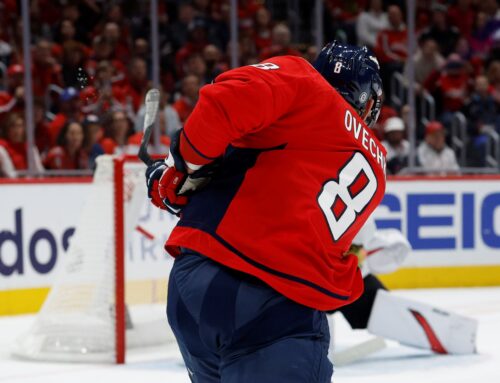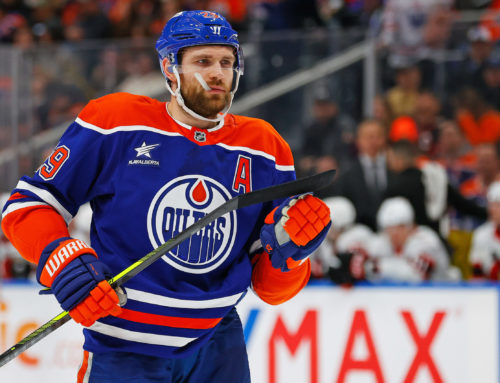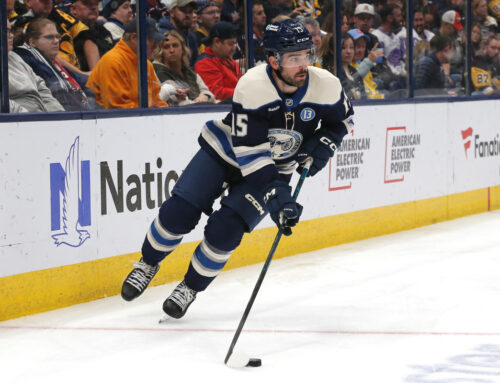
It was announced on Friday that New York Rangers defenceman Kevin Klein would be retiring from the NHL after a 12-year career.
Starting his career in Nashville before being traded to the Rangers, Klein had seemed to settle into a second/third-pair role with New York. His role – as that article indicates – had started to diminish last year, however. He leaves the league with 154 points in 627 career games.
What the future holds for Mr. Klein is up in the air, but he was usually a solid NHL blue liner, and I wish him and his family all the best moving forward.
****
The 2017-18 Dobber Fantasy Hockey Guide is available for pre-order now in the Dobber shop. For those to grab a copy early to be able to digest all the information you can before heading into drafts.
****
After being bought out by the Florida Panthers, a new home for Jussi Jokinen seemed imminent. Given the market for wingers over the age of 30 this off-season has been very low-risk (think of Patrick Sharp, Ales Hemsky, Mike Cammalleri, and Scott Hartnell), one team would get themselves a good middle-six left winger for cheap.
Edmonton signed Jokinen to a one-year contract for $1.1 million.
This is a good signing for the Oilers. While he’s never been one to score in abundance, Jokinen is a good distributor, and a good two-way forward. Getting that for cheap is a big plus for the depth up front.
I will say that this could be a headache for fantasy owners. There are so many options at each of the forward positions that line combinations could change on a nightly basis. Consider:
- The team has long wanted to put Leon Draisaitl at centre, but that would push Ryan Nugent-Hopkins to the third line, which seems a bit of a waste of cap space. Should they also want to use Ryan Strome as a centre, that would push Strome to the fourth line. Or they could put Strome on the top line with Connor McDavid.
- It would make sense to put Jokinen and RNH together as a shutdown-ish tandem. If they do that with Draisaitl staying alongside Connor McDavid, that would probably push Milan Lucic to the third line with Patrick Maroon staying on the top line, and I’m not sure they want to do that.
- Where do Anton Slephyshev and Jesse Puljujarvi play? With Maroon, Jokinen, and Lucic all left wingers, Slepyshev could end up on either the first or fourth line, and that’s a gigantic chasm in fantasy relevance. Does Puljujarvi play a sheltered third-line role with Lucic and Strome? That would make sense, but then that pushes Kassian to the fourth line. Not necessarily a bad thing in the real world, but bad for fantasy.
There are so many forwards that could play so many different roles for this team that at this point it’s hard to say anything with any degree of certainty other than ‘Connor McDavid is the first-line centre.’ Having depth is great for the franchise and its fans, but it could be a headache all year long for fantasy owners.
For Neil Parker's take on the signing, check it out here.
****
Throughout the summer, I am going team by team and discussing the notable fantasy performances from the 2016-17 season, and what it could tell us moving forward. Now that free agency and the trade market has died down quite a bit, I’ll be doing these more frequently.
Next on the list is the Minnesota Wild.
Eric Staal and Nino Niederreiter
After five straight seasons with fewer than 25 goals, and coming off a year with 39 points in 83 games, I’m not sure even the most optimistic fans and prognosticators envisioned a 28-goal, 65-point season from Staal. Add in 16 power-play points and over 200 shots on goal, and Staal was one of the best roto draft values.
It is fair to wonder, however, if that can continue next season.
Of those 28 goals, 18 were scored at five-on-five. What is curious about those 18 goals is that they came off the second-lowest shots per 60 minute mark for him in the Behind The Net era, or since 2007-08 (it was 7.92, with his lowest of 7.64 coming the year before). He managed those 18 goals because he shot the second-highest five-on-five mark of his career at an even 12 percent, which was only bettered by the 13.13 percent of his lockout-shortened season.
As usual, we look to HockeyViz to see if anything changed in his shot location. The first graphic is from his last full season in Carolina, and the second one is from his first full season in Minnesota:


Without posting too many of these, his 2015-16 heat map looks very similar to the one from the year before, so it’s not like he was getting to the net at an unforeseen rate. He was finally converting. Is there a bit of luck here? Sure, but I’d argue one of his frequent line mates was a big part of this: Nino Niederreiter.
Building off work done by Ryan Stimson for shot assists (passes that lead directly to shots on goal), the crew at NHLNumbers found two particularly dangerous types of passes: from behind the net, and cross-seam passes, as well as the shots that result from these passes. That seems intuitive to some, but NHLN actually tracked games and ranked the players by these types of passes and shots. I recommend going to read both articles, but the short version of the list for five-on-five play in the 2015-16 season is here:

We know how well the Sedins play off each other, and the rest of the Jamie Benn and Tyler Seguin’s magic, Joe Thornton and his passing, and so on. But Niederreiter has his name near the top of this list as well. In the 2016-17 season, he played alongside Staal for nearly 526 of Staal’s 1136:32 total five-on-five ice time. The Wild scored 3.42 goals per 60 minutes with those two on the ice, and Staal on the ice without Nino fell by almost a full goal per minute (and shot attempts fell as well).
I wouldn’t argue that Niederreiter is the sole reason that Staal’s shooting percentage nearly doubled in one year, but it shouldn’t be a huge surprise that playing with a winger who is among the elite at finding himself in good situations to shoot and distribute helped the point totals of his centre.
The question is if that continues next year. Niederreiter filed for arbitration, so he should return. But does he play on Staal’s wing as much as he did last year? That’s up the coaching staff. Given their results, they should play most of the year together, but weirder things have happened.
In that link posted above from NHLN’s primary dangerous shot contributions, Granlund finished near the top of the league in 2015-16 for primary assist contributions (and way lower on the list for actual shots). The fact that he set a career-high with 43 assists isn’t a big shock; he did have three straight seasons with over 30 assists, and with a career-high in five-on-five total ice time and his line mates finally finishing at a commensurate rate to his passing talent, it all finally came together. He should be able to reach close to 40 assists again.
What is curious is the 26 goals he scored, considering he had just 31 in his 240 career regular season games to that point. Obviously, shooing 14.7 percent in 2016-17 after shooting 7.8 percent from 2012-16 is the reason why. It’s the goal distribution which piqued my interest:
- 11 goals at five-on-five, only three more than his previous career-high of eight in 2014-15
- 7 power-play goals
- 4 empty-net goals
- 3 short-handed goals
- 1 goal at three-on-three
It’s the short-handed and empty-net goals that are concerning. He had one short-handed goal in his career before last season, and two empty-net goals in those same 240 games. Obviously, being used more while short-handed than before will help here, as well as being used at the end of the game. But relying on those two categories to get over the 25-goal mark again is a mistake. It’s worth noting that he shot 8.21 percent at five-on-five, which is above his career average, but not otherworldly.
Expecting more than 20 goals again from Granlund next year is a mistake for fantasy owners. Any number of things could offset the goal-scoring regression – more shots, more power-play time, a spike in five-on-five shooting percentage – but relying on any of these when norms have already been established doesn’t seem to be prudent. He can be a 20-goal, 60-point player again, but that’s about as high as expectations should get.
It was another 40-point season for Minnesota’s top blue liner, his third in four 82-game seasons since signing with the team. It was also, however, a considerable drop-off from the year before when he managed 51, and well below the 47-point per 82-game mark he set through his first four years in Minnesota.
The long and short of it was the drastic decline in power-play assists was responsible for this point decline. With the man advantage, Suter procured just eight assists, his lowest mark in the last decade.
How Suter got to the point where he managed so few power-play assists is fairly straightforward: ice time. From 2013-16, his first three 82-game seasons in Minnesota, he managed 2.78 assists per 60 minutes of power-play time, and that number was 2.17 in 2016-17. A drop-off, yes, but that would explain a drop of three or four assists, not 10. Rather, it was that he averaged a full minute less in power-pay time per game that would account for the rest of the assists.
This trend of fewer power-play minutes for Suter may not change this season, as Matt Dumba and Jared Spurgeon should continue to eat into those minutes as they have in recent seasons. That is a problem for Suter’s production, as all his big seasons in the points column have come when he can manage in the neighbourhood of 20 power-play points. Should the ice time trend continue in 2017-18 – and I think it does – expecting more from Suter than what he produced last year is expecting too much. Considering he isn’t a defenceman who stuffs any of the peripheral stats for roto leagues, he should be drafted as a top-20 option from the blue line rather than a top-12.
2 Comments
Leave A Comment
You must be logged in to post a comment.





 N.J
N.J NYR
NYR OTT
OTT FLA
FLA DAL
DAL PIT
PIT VAN
VAN ANA
ANA L.A
L.A EDM
EDM BUF
BUF T.B
T.B MTL
MTL PHI
PHI TOR
TOR CBJ
CBJ UTA
UTA WPG
WPG BOS
BOS CAR
CAR STL
STL COL
COL CGY
CGY VGK
VGK S.J
S.J SEA
SEA WSH
WSH CHI
CHI

I had Staal pegged for a rebound with 21 goals and 53 points, but I wasn’t expecting a season like that, but quite a few Wild players took off last season.
The Wild need to keep reducing Suter’s minutes to lower the odds of him suffering a significant injury and keep him fresh for the playoffs. Dumba’s a much younger D with better offensive talent than Suter, so they should flip the 2 on the PP.
Maybe they should but I’m not sure they go fully in that direction. I assume it’s closer to a split like it was last year.